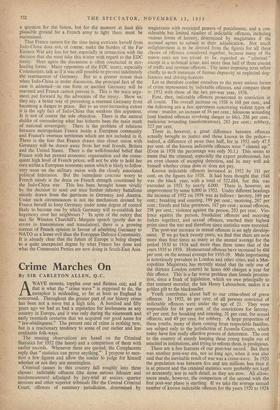Crime Marches On
By SIR CARLETON ALLEN, Q.C.
WAVE mounts, topples over and flattens out; and if that is what the "crime wave" is supposed to do, the metaphor is misleading, so far at least as England is concerned. Throughout the greater part of our history crime has been not a wave but a high tide. A hundred and fifty years ago we had as bad a reputation for lawlessness as any country in Europe, and it was only during the nineteenth and early twentieth centuries that we acquired our good name for " law-abidingness." The present rate of crime is nothing new, but is a reactionary tendency to some of our earlier and less creditable folk-ways.
The ensuing observations are based on the Criminal Statistics for 1952 (the latest) and a comparison of them with earlier records. Whenever these are quoted, the Complacents reply that "statistics can prove anything." I propose to men- tion a few figures and allow the reader to judge for himself whether or not they are meaningless.
Criminal causes in this country fall roughly into three classes : indictable offences (the more serious felonies and misdemeanours) adjudged by jury-trial at assizes, quarter sessions and other superior tribunals like the Central Criminal Court; offences of summary jurisdiction, determined by magistrates with restricted powers of punishment; and a con- siderable but limited niimber of indictable offences, including various forms of larceny, determined by magistrates if the accused agrees to submit to their adjudication. Not much enlightenment is to be derived from the figures for all these classes of offences considered together, because many of the minor ones are too trivial to be regarded as " criminal " except in a technical sense, and more than half of them consist of traffic and revenue offences. The latter imposing term refers chiefly to such instances of human depravity as neglected dog- licences and driving-licences.
Let us therefore confine ourselves to the more serious forms of crime represented by indictable offences, and compare them in 1952 with those of the last pre-war year, 1938. First, then, indictable offences prosecuted to conviction in all 'courts. The overall increase on, 1938 is 168 per cent., and the following are a few .specimens concerning violent types of crime : murder, an increase of 56 per cent.; felonious wounding (and kindred offences involving danger to life), 256 per cent.; malicious wounding (misdemeanour), 283 per cent.; robbery, 327 per cent.
There is, however, a great difference between offences actually brought to justice and those known to the police— indeed, a difference of more than half, for in 1952 only 47.5 per cent. of the known indictable offences were "cleared up." (Even in 1938 the percentage was only 50.1.) This seems to mean that the criminal, especially the expert professional, has an even chance of escaping detection, and he may well ask . himself whether crime does or does not pay. Known indictable offences increased in 1952 by 181 per cent. on the figures for 1938. It had been thought that 1948 was the black year, with a total of 522,684, but this was exceeded in 1951 by nearly 4,000. There is, however, an improvement by some 9,000 in 1952. Under different headings the increase of 1952 on 1938 was as follows : larceny, 169 per cent.; breaking and entering, 199 per cent.; receiving, 267 per cent.; frauds and false pretences, 167 per cent.; sexual offences, 298 per cent.; violence against the person, 253 per cent. Vio- lence against the person, fraudulent Offences and receiving (taken together), and sexual offences, reached their highest point since the war and therefore since statistics were recorded.
The post-war increase in sexual offences is an ugly develop- ment. If we go back twenty years, we find that there are now more than four times as many as the annual average for the period 1930 to 1934 and more than three times that of the years 1935 to 1939. Homosexual offences have increased by 486 per cent. on the annual average for 1935-39. Male importuning is notoriously prevalent in London and other cities, and a Met- ropolitan Magistrate, has recently stated that (in only one of the thirteen London courts) he hears 600 charges a year for this offence. • This is a far worse problem than female prostitu- tion, since a freak of legislation, which we owe principally to that eminent moralist, the late Henry Labouchere, makes it a golden gift to the blackmailer. Youth contributes about half to our crime-sheet of grave offences. In 1952, 46 per cent, of all persons convicted of indictable offences were under the age of 21. They were responsible for 44 per cent. of the convictions for larceny, 67 per cent. for breaking and entering, 31 per cent, for sexual offences, and 49 per cent. for robbery. A large proportion of these youths, many of them coming from respectable families, are subject only to the jurisdiction of Juvenile Courts, which today have few really effective powers of deterrence. The cost to the country of merely keeping these young toughs out of mischief in institutions, and trying to reform them, is prodigious. These are a few features of our postwar record. But there was another post-war era, not so long ago, when it was also said that the inevitable result of war was a crime-wave. In 1920 the population was between five and ten millions less than it is at present and the criminal statistics were probably not kept so accurately, nor in such detail, as they are now. All allow- ances made, however, the comparison of the second with the first post-war phase is startling. if we take the average annual number of known indictable offences for the years 1920 to 1924
































 Previous page
Previous page